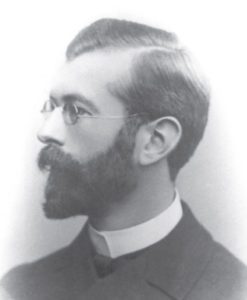If you have ever taken a water or bottom sample in a freshwater lake, you owe your success to Vagn Walfrid Ekman, the namesake for the Ekman Water Bottle and Ekman Dredge.
Ekman was born on May 3, 1874, the son of a Swedish oceanographer. Ekman went to the University of Uppsala to study physics, but ocean science must have been in his DNA—he quickly switched to oceanography. Oceanography became his life’s work, most of which was performed while he was a professor at the University of Lund in Sweden.
While still a student, he learned about a peculiar behavior of floating icebergs. Rather than moving in the direction of the prevailing wind, icebergs moved off at an angle. Presented with this unsolved dilemma, Ekman performed a theoretical analysis that proved an iceberg’s path was the combination of wind, friction of moving water layers and the Coriolis force of the earth’s rotation. It explained why icebergs moved off in one direction in the northern hemisphere and the opposite in the southern hemisphere.

His understanding of the detailed movements of ocean waters led him to several other discoveries. He determined the cause of so-called “dead water” in Scandinavian fjords was the resistance of cold water layers from melting glaciers on the surface of the ocean. He expanded his work with icebergs into a more general treatment of the movement of water at various depths in the ocean, noting and explaining the deflection of currents again as a balance of wind, friction and Coriolis forces. The phenomenon, which he explained in a 1905 paper, is called the Ekman Spiral in his honor. He went on to develop full theoretical analyses of wind-blown ocean currents.
But his work as an experimental scientist is what has made him a common name among freshwater biologists. He was more than just a theoretician—he excelled at field work as well. His theories relied on having accurate measurements of aquatic phenomena at various depths. To collect the data, he invented devices that could be lowered to the appropriate depth and then activated from the surface. The Ekman Dredge works by lowering an open set of jaws to the bottom of a lake on a rope and then sending a heavy weight down the rope that trips a trigger, closing the jaws. He also invented the Ekman Bottle, which works similarly—a bottle is lowered to the desired depth, is opened by a dropped weight, fills with water, and then is closed by a second dropped weight. He also invented a device to measure water currents. All these tools continue in use today, elegant in their simplicity and efficient in their reliability.
I used Ekman Dredges often in my early research, but my most successful use was with a kindergarten class. I was telling the children about how much life lives in the bottom of a lake, but that we can’t see it because it is below the surface. I showed them how an Ekman Dredge worked by simulating the lake bottom with sand in a plastic swimming pool. When a student sent the weight down the line and thus scooped up a big bite of sand, we put it through a sieve. And out popped wrapped candy bars that I had buried in the sand.
Thank you, Vagn Ekman!
References:
Ichiye, Takashi. 2018. V. Walfrid Ekman. Encyclopedia Britannica.com. Available at: https://www.britannica.com/biography/V-Walfrid-Ekman. Accessed May 1, 2018.
Knight, J. D. Meet the Ocean Explorers: Vagn Ekman. Available at: http://www.seasky.org/ocean-exploration/ocean-explorers-vagn-ekman.html. Accessed May 1, 2018.
Welander, Pierre. Ekman, Vagn Walfrid. Encyclopedia.com. Available at: https://www.encyclopedia.com/science/dictionaries-thesauruses-pictures-and-press-releases/ekman-vagn-walfrid. Accessed May 1, 2018.
